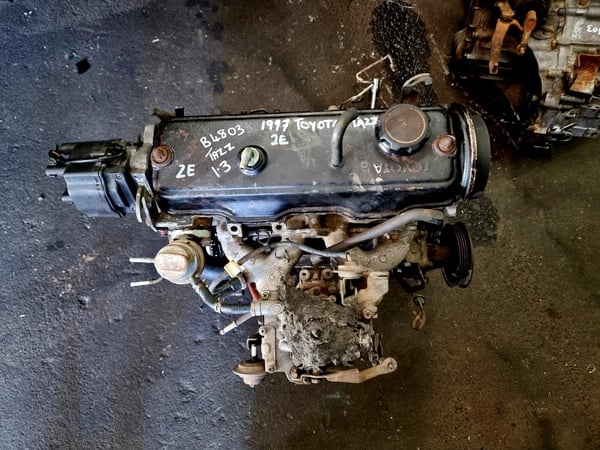Discover the Newest Patterns in Engine Modern Technology Through Tazz
In the quickly progressing landscape of automobile technology, Tazz stands at the forefront, highlighting considerable improvements in engine systems that focus on both technology and sustainability. tazz. From crossbreed engines that optimize gas efficiency to the emergence of hydrogen fuel cells, the trends shaping modern powertrains are not only enhancing efficiency however additionally addressing crucial environmental challenges. As the industry remains to push boundaries, it is important to think about exactly how these advancements will influence future transportation solutions and the more comprehensive effects for international power usage. What lies ahead in this pivotal transformation?
Hybrid Engine Innovations
Crossbreed engine innovations represent a pivotal shift in automotive technology, combining the advantages of inner combustion engines with electric propulsion systems. This combination not only boosts fuel performance but additionally decreases discharges, conference significantly stringent environmental guidelines. By utilizing both power resources, hybrid engines can enhance performance, supplying power when needed while preserving gas during much less requiring driving conditions.
Recent innovations in crossbreed innovation consist of enhancements in battery performance and regenerative stopping systems. These innovations enable higher energy recovery during deceleration, which can be redirected to aid in velocity or power accessory systems. Additionally, producers are concentrating on portable layouts and lightweight products to maximize the performance of crossbreed powertrains.
The advancement of plug-in hybrids has additionally increased the market, making it possible for drivers to charge their lorries using conventional electric outlets. This attribute typically enables for substantial all-electric range, further lowering dependancy on conventional fuels. tazz. As the automotive industry remains to develop, hybrid engine technologies are anticipated to play an essential role in connecting the void between standard automobiles and fully electric designs, offering a transitional solution that deals with diverse consumer requirements and preferences
Advances in Electric Powertrains
The automotive landscape is swiftly advancing, with electrical powertrains emerging as a leading force in sustainable transport. Breakthroughs in electric vehicle (EV) technology are significantly enhancing efficiency, effectiveness, and individual experience. Secret developments include renovations in battery chemistry, which have increased power density, lowered charging times, and expanded general battery life.
Solid-state batteries, for instance, assure to reinvent the market by supplying greater safety and security and effectiveness contrasted to conventional lithium-ion cells. Additionally, innovations in regenerative braking systems are making it possible for cars to recuperate energy during slowdown, adding to total efficiency.
Along with battery innovation, electrical motor layouts are becoming a lot more innovative. Developments such as incorporated electric motors and progressed thermal management systems are assisting to maximize power delivery and decrease weight, inevitably boosting car characteristics.

Jointly, these breakthroughs emphasize the dedication to change in the direction of cleaner, extra reliable transport options, placing electric powertrains at the leading edge of automobile advancement.
The Rise of Hydrogen Gas Cells
Significantly, hydrogen gas cells are gaining traction as a practical choice to traditional internal combustion engines and battery electrical vehicles. This innovation utilizes the chemical energy kept in hydrogen, converting it right into electrical power via an electrochemical reaction with oxygen. The primary by-product of this process is water, making hydrogen fuel cells an eco-friendly option with absolutely no discharges at the tailpipe.

Automakers are progressively spending in hydrogen gas cell technology, acknowledging its possibility for long-range applications and quick refueling capabilities that match traditional gas. In addition, sectors such as heavy-duty transport and public transit are especially fit for hydrogen gas cells, where battery electrical remedies may fall short due to weight and range restrictions.
As research study and financial investment proceed to increase, hydrogen gas cells are positioned to play a substantial duty in the future landscape of tidy transport and power remedies.
Enhancements in Internal Burning Engines
Technologies in inner combustion engine (ICE) technology are changing standard cars to meet modern-day ecological standards and efficiency assumptions. Direct gas shot, for instance, permits for much better atomization of fuel, leading to even more total burning and improved power output.
In addition, turbocharging has gained prestige, allowing smaller sized engines to provide greater efficiency without the weight of larger engines - tazz. This modern technology not only boosts performance however additionally adds to lower gas consumption. Variable shutoff timing systems are also being improved, allowing engines to adjust to different driving get more problems for enhanced torque and responsiveness
Moreover, using light-weight materials in engine construction is coming to be conventional, more improving fuel performance by reducing general vehicle weight. Engine control devices (ECUs) are increasingly advanced, allowing real-time changes that enhance efficiency and discharges.
These improvements collectively symbolize a critical change in ICE technology, straightening with global sustainability objectives while still supplying the efficiency vehicle drivers anticipate from their vehicles. As the industry look at these guys evolves, these enhancements continue to form the future of typical auto engineering.
Future Patterns in Engine Effectiveness
Significant innovations in engine effectiveness are prepared for as makers concentrate on integrating advanced innovations to fulfill rigorous ecological laws and customer needs. The change towards electrification, hybrid systems, and alternative gas is reshaping the automotive landscape, driving developments that enhance fuel economy and decrease discharges.
One of the essential trends is the implementation of advanced materials and manufacturing techniques. High-strength alloys and light-weight compounds contribute to decreased car weight, therefore improving overall performance. In addition, the fostering of turbocharging and variable shutoff timing innovations enables improved power output from smaller engines, further enhancing gas economic situation.

Conclusion
Advancements in crossbreed engine systems, electrical powertrains, and hydrogen fuel cells demonstrate a commitment to minimizing exhausts while boosting performance. Improvements in interior burning engines and an emphasis on light-weight products add to total engine efficiency.
From hybrid engines that optimize fuel effectiveness to Look At This the introduction of hydrogen gas cells, the fads forming modern-day powertrains are not just boosting efficiency yet also dealing with vital environmental difficulties.Hybrid engine advancements stand for an essential change in vehicle innovation, integrating the benefits of interior combustion engines with electric propulsion systems.Additionally, turbocharging has gained prominence, allowing smaller sized engines to supply greater efficiency without the weight of larger engines. Additionally, the adoption of turbocharging and variable shutoff timing modern technologies permits for enhanced power outcome from smaller engines, further boosting gas economic climate.
Enhancements in internal combustion engines and an emphasis on light-weight materials add to total engine effectiveness.